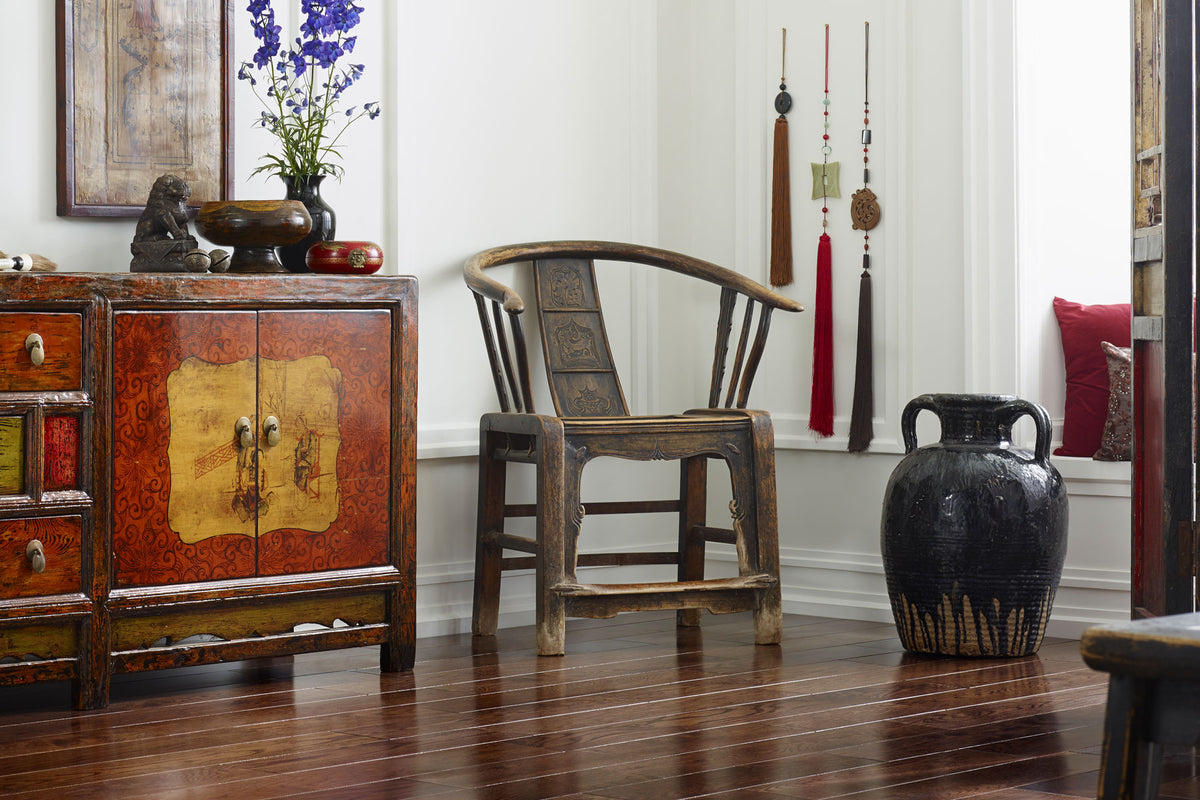
Horseshoes, Yoke-Backs and Southern Officials – highlighting some of the Chinese chairs in our antique collection
We’re just in the process of finalising another shipment of Chinese antiques from Beijing – due to leave in a few weeks from now. Most of the pieces have already been selected and the latest ones were added onto our website last week. Among them are two more pairs of exquisite Chinese chairs to add to several others that we already have in stock, so this seems like a good time to highlight some of the beautiful designs and ingenious construction that the Chinese produced over centuries in chair design.
The chair in China developed early on in the country’s history, with simple stools and seating appearing during the Tang dynasty (618 to 907AD). This was in contrast to most other Asian countries, where the practice of sitting at floor level continued for centuries to come.
| Yoke Back Side Chairs in Elm, Shanxi | Yoke-Back Armchairs in Walnut, Shanxi | Horseshoe Back Chairs in Willow, Shandong |
| Southern Official Armchairs in Elm, Beijing | Qing Style Armchair in Walnut, Shanxi | Pair of Horseshoe Armchairs in Elm, Shanxi |
From as early as the 6th century one of the most recognisable styles of chair started to appear, and continues to be made in China today with very little modification. This style is usually referred to today as a ‘Yoke-Back’ armchair due to the distinctive shape of the crest rail that extends over the two side stiles, but is also known as an ‘Official’s Hat Chair’ as the same rail also resembles the hats worn by government officials during the Ming period. The chairs started as seating for royalty, but were soon in common usage amongst the Chinese elite, reserved for important house guests. By the early Ming dynasty these chairs were beautifully proportioned, usually with a back splat curved in an ‘S’ shape, with curved armrests (signifying good ‘qi’ or energy) and subtly tapered supporting posts. The apron below the seat would often be curved and the stretchers between the legs positioned with the front one closest to the ground, the side stretchers slightly higher and the rear stretcher highest of all. This placement, known as ‘bubugao’ in Chinese (literally ‘step higher’) was symbolic of career progression.
The designs of the chair changed little across different regions. The main variations tended to be in the vigour of the curves, particularly in the crest rail, with chairs from Shanxi in central China being noted for their strong lines. It was also the practice to decorate the back splat with symbols for good luck, prosperity or long life. In central areas animals (such as bats for good luck or the ‘ruyi’ symbol to grant wishes) were common, while in the eastern province of Shandong for example, carvings of the Chinese character ‘fu’ (for good luck) were prevalent.
This style also developed into the similar side chair, without armrests, which would be used for more general seating and dining. The chairs would be placed formally in pairs, often either side of an altar table in a main reception room, but brought into the centre of the room for entertaining guests.
A further development from the Yoke-Back style is what is referred to as the ‘Southern Official’s Armchair’. This appeared later on in the country’s history, supposedly first in the the southern province of Jiangsu, but soon became popular throughout China. Instead of the extending crest rail of the Yoke-Back chair, the rail joins the rear stiles and the arms join the front supporting posts, giving a very fluid, less imposing appearance. Similar, smaller chairs with solid or carved backs rather than back splats also appeared around the same time. Usually known as rose chairs, these were used by women, usually in their private chambers.
The other most distinctive style of Chinese chair is the ‘horseshoe’ back armchair. Also referred to as ‘Grand Tutor Chairs’ these pieces played an important role in Chinese society, used for ceremony and as seats of honor for the most important guests. They were probably also used for transport, with wooden poles being fitted along the sides so that four servants could easily carry the chair and its owner. The unmistakeable curved semicircular armrests were produced usually using five pieces of curved wood that were fitted together using a series of ingenious overlapping joints. The chairs were made with generous proportions befitting the status of the sitter, but are surprisingly comfortable.
More simple versions of the horseshoe chair were also produced in Shandong and other provinces out of softwood such as willow. This meant that the curved armrests could be made from a single piece of wood rather than with the complicated joins of the more refined versions.
During the Qing dynasty, around the 18th century, tastes began to change amongst China’s elite, with the focus starting to turn towards a heavier, more elaborate style. Out of this came a new type of chair, sometimes referred to as an ‘Emperor Chair’ as they again were made to denote the status of the sitter. These were made with a heavy, ‘waisted’ seat on top of which would be oranately carved armrests and back splats, the backs also often being fitted with marble.
As well as our antique pieces, you will find reproduction versions of most of these wonderful styles of chairs in our Classical Chinese furniture range – the proportions slightly modified to make them more suitable for a western home. The Yoke-Back chairs, with carved dragon motifs in the backrest, make wonderful dining chairs, while our horseshoe and southern official chairs are great as statement pieces in a bedroom or living room. However, for their sheer presence and sense of history as well as for the beauty of their curves and workmanship, a pair of antique Chinese chairs is the ultimate in seating – placed either side of a console table they add instant impact to any modern reception room.



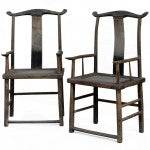
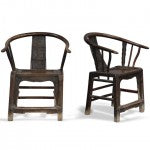
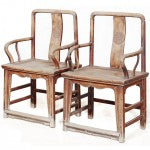
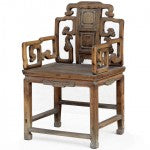
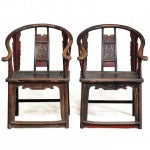



Leave a comment